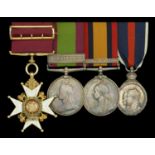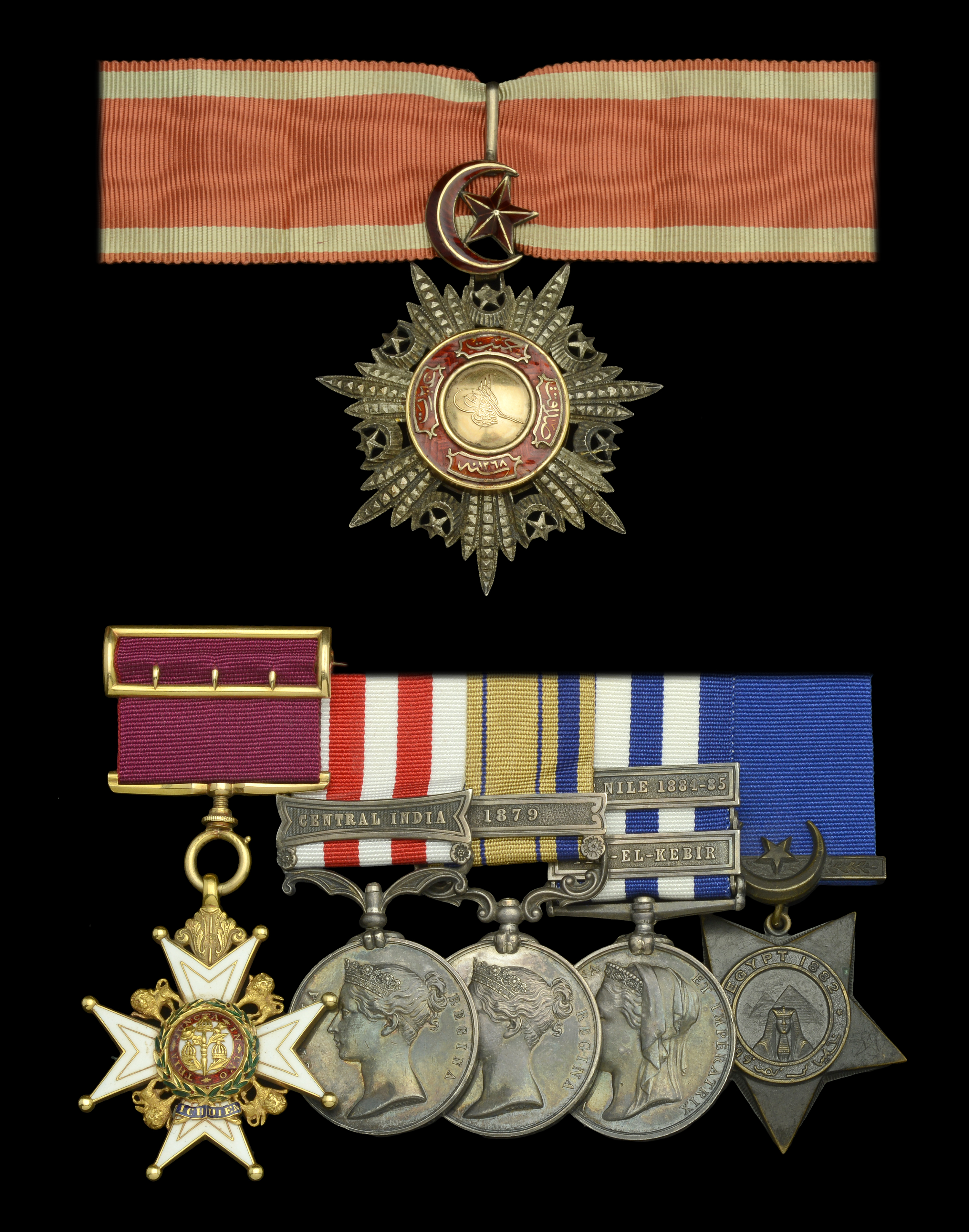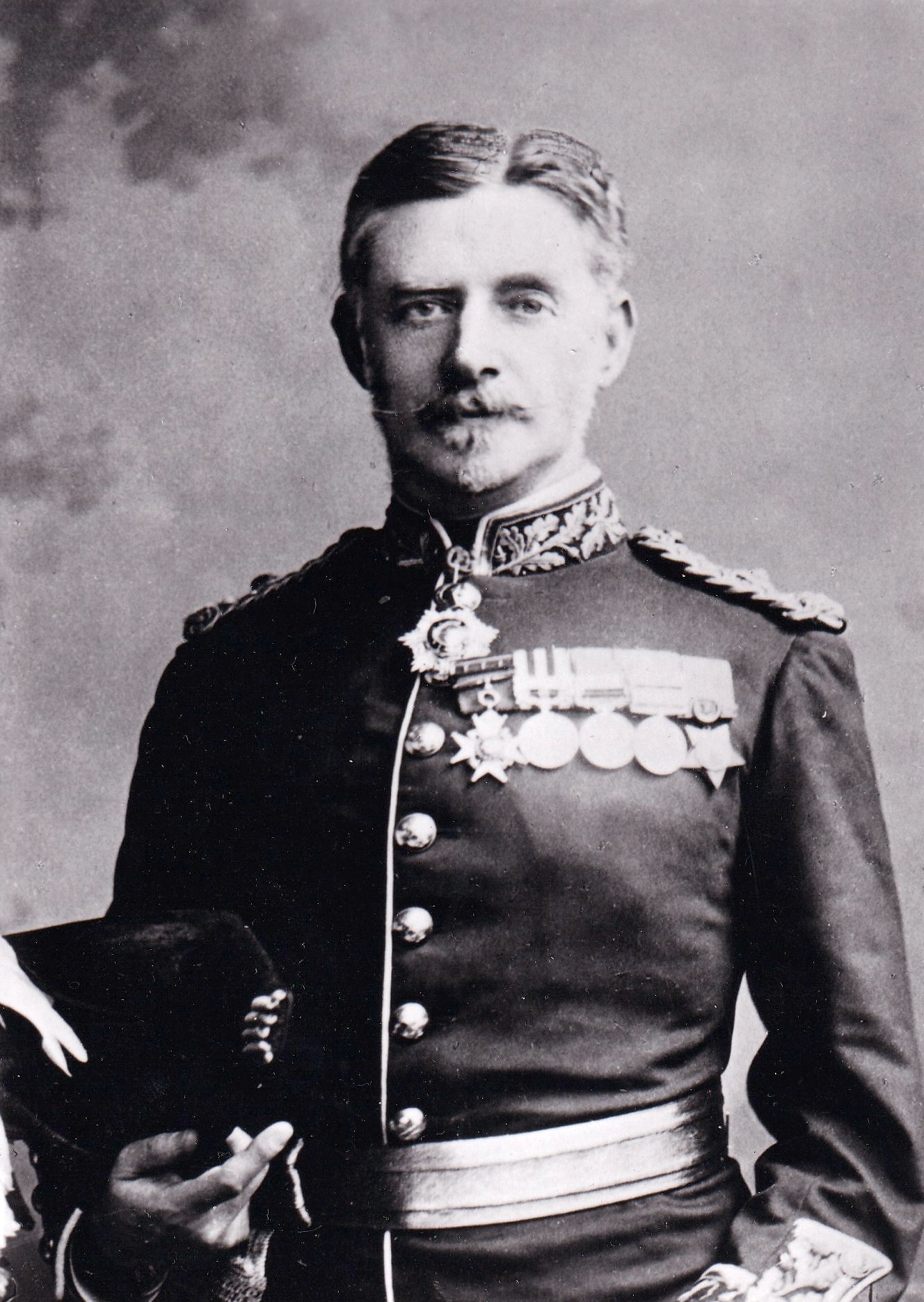A fine ‘Egypt 1882 campaign’ C.B. group of six awarded to Major-General C. E. Webber, Royal Engineers, who was distinguished at the capture of Jhansi in April 1858 and was afterwards in charge of Army Telegraphs in South Africa 1879, Egypt 1882, and on the Nile Expedition in 1884-85 The Most Honourable Order of the Bath, C.B. (Military) Companion’s breast badge, 18 carat gold and enamels, hallmarked London 1881, complete with gold ribbon buckle; Indian Mutiny 1857-59, 1 clasp, Central India (Lieut. C. E. Webber, Royal Engrs.); South Africa 1877-79, 1 clasp, 1879 (Lt. Col: C. E. Webber. R.E.); Egypt and Sudan 1882-89, dated reverse, 2 clasps, Tel-El-Kebir, The Nile 1884-85 (Lt. Col: C. E. Webber. R.E.); Khedive’s Star, dated 1882; Ottoman Empire, Order of the Medjidieh, 3rd Class neck badge, 83mm including Star and Crescent suspension x 66mm, silver, gold appliqué, and enamel, with silver mark to obverse and mint mark and silver mark to reverse, minor chipping to enamels on C.B., otherwise toned, good very fine or better (6) £5,000-£7,000 --- Charles Edmund Webber was born in Dublin on 5 September 1838, the son of the Revd T. Webber of Leekfield, Co. Sligo, and his wife, of Kellavil, Athy. After education at private schools and at the Royal Military Academy, Woolwich, he was commissioned lieutenant in the Royal Engineers on 20 April 1855. The demands of the Crimean War cut short his professional instruction at Chatham, and he was sent to the Belfast military district, being employed principally on the defences of Lough Swilly. In September 1857 Webber was posted to the 21st company of Royal Engineers at Chatham, which was ordered to India to join the Central India field force commanded by Major-General Sir Hugh Rose. Brigadier C. S. Stuart's 1st brigade, to which Webber's company was attached, marched on Jhansi, which Sir Hugh Rose's column reached by another route. Webber was Mentioned in Despatches for his services on this arduous march. He took part in the Battle of the Betwa River on 1 April, and in the assault of Jhansi on the 3rd, for which he was promoted. Webber took part in the operations attending the capture of Kunch (7 May), of Kalpi (23 May), and of Gwalior (19-20 June). Webber’s distinguished services at the capture of Jhansi on 3 April 1858 are recorded in The History of the Corps of Royal Engineers: ‘Another brilliant episode in this war, so full of heroic incidents, was the capture of Jhansi by the Central India Field Force under Sir Hugh Rose... The city of Jhansi was surrounded by an enceinte wall from 6 to 12 feet thick, and varying in height from 18 to 30 feet, flanked by bastions, in which guns were mounted. The fort which formed the citadel was of granite, from 16 to 20 feet thick, almost impervious to artillery. It was perched on the summit of a rock, and commanded the city. The south was the only side offering any possibility of a successful attack; there the city wall which sprang from the centre of its face ran southward, ending in a mound or mamelon, at which point it changed direction to the east, and made the circuit of the city. This mound was fortified by a strong circular bastion, with a wide and deep ditch. In order to attack the fort with success on the only vulnerable side it was necessary to capture this point, and hold the city wall. Two batteries were established, one on the right where the mound and wall could be taken in reverse, the other on the left whence the enceinte and fort could be battered. As soon as the city wall had been breached near the mound it was decided to assault at that point, and at the same time to attempt an escalade at other places. The 1st Brigade was to storm the breach and to escalade at the Rocket Bastion on its left. The 2nd Brigade was to escalade on the right. Lieutenant Webber, R.E., led the escalading party on the left, and Lieutenant Gossett, R.E., the stormers of the breach. The attack on the right was in two columns, one led by Lieutenants Meiklejohn and Dick of the Bombay Engineers, and the other by Lieutenant Bonus, Bombay Engineers, and Lieutenant Fox, Madras Sappers and Miners. The breach was carried without much difficulty, as a heavy fire had been kept up on it throughout the night; but it was so strongly stockaded that it would not have been readily forced had the garrison made a determined resistance. The left escalading column led by Webber met with more opposition. The wall was here 27 feet high, and loopholed. The enemy had prepared large masses of stone which they pushed over, breaking many rungs of the ladders; they also fired rockets through the loopholes. The two men first in were Lieutenant Dartnell, 86th Regiment, and Lieutenant Webber. The former was severely wounded before Webber could come to his assistance. After a sharp struggle a footing was gained, and the enemy driven from the bastion... Corporal Michael Sleavon, 21st Company, R.E., gained the Victoria Cross during the street fighting on the day of the assault.’ Webber commanded a detachment of engineers which joined a flying column under Captain McMahon, 14th light dragoons, in Central India against Tantia Topi, Man Singh, and Firuz Shah, and was again Mentioned in Despatches. He continued in the field until April 1859, after which he was employed in the public works department, first at Gwalior and afterwards at Allahabad, until he returned to England in May 1860. After service in the Brighton sub-district until October 1861, Webber was until 1866 assistant instructor in military surveying at Woolwich. He was promoted Captain on 1 April 1862. During the latter part of the Austro-Prussian War in 1866 he was attached to the Prussian army to report on the engineering operations and military telegraphs. Various services on special missions abroad followed, with duty at the Curragh camp (1867-9). The 22nd Company of Royal Engineers, of which he was in command at Chatham, was as a temporary expedient lent to the Post Office from 1869 to 1871 to assist in constructing and organizing the telegraph service. In May 1870 Webber took his headquarters to London, the rest of the company being distributed about the country. In 1871 the 34th Company was added to Webber's command and stationed at Inverness. The total strength of the Royal Engineers at that time employed under the Post Office was six officers and 153 non-commissioned officers and men. The mileage both over and under ground constructed and rebuilt in 1871 was more than 1000 line miles and more than 3200 wire miles. Webber, who was promoted Major on 5 July 1872, was director of telegraphs with the southern army in the autumn manoeuvres of that year. In 1874, at his suggestion, the south of England was permanently assigned for the training and exercise of military telegraphists, with five officers and 160 non-commissioned officers and men being employed by the Post Office there. The scheme proved of value both to the army and the Post Office. While employed under the Post Office he, with Colonel Sir Francis Bolton, founded in 1871 the Society of Telegraph Engineers (subsequently the Institution of Telegraph Engineers); he was treasurer and a member of council, and in 1882 was president. Webber's reputation as an expert on military telegraphy was well established when in May 1879 he resumed active military service in the field. Accompanying Sir Garnet Wolseley to South Africa for the Anglo Zulu War, he became Assistant Adjutant and Quartermaster-General on the staff of the inspector-general of the lines of communication. He was stationed at Landmann's Drift. He afterwards took part in the operations against Sekukuni in the Transvaal, and was once again Mentioned in Despatches. Promoted regimental Lieutenant-Colonel on 24 January 1880, Webber on his retu...









